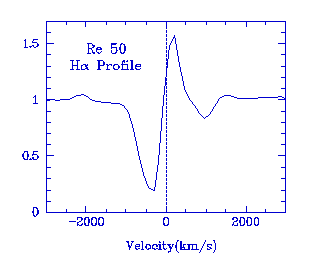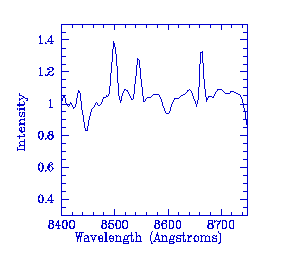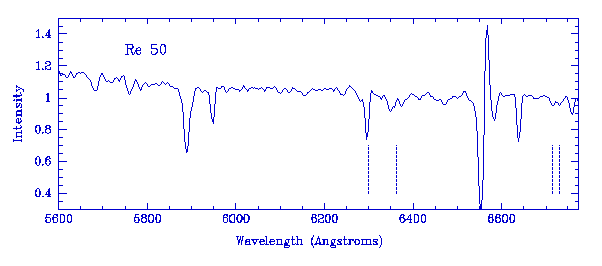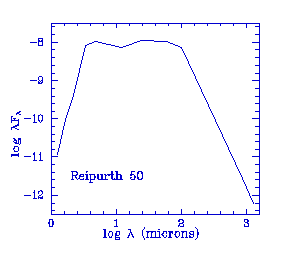This is a plot of part of the spectrum of Re 50 taken by placing the slit of the
spectrograph along the brightest part of the reflection nebulosity.
The H line (6563 Å) profile shows the
distinctive signature of an FU Ori star, with the extent of the blue wing of this
line indicating extreme outflow velocities (up to 1000 km/s for Re 50!).

Another interesting spectral region is the region around the infrared Ca triplet. These 3 lines (8498, 8542, & 8662 Å) all appear in emission. A variety of behavior is seen among the FU Ori objects in these lines.

Here is a broader view of the spectrum of this object at red wavelengths. The dashed lines show wavelengths at which the subtraction of the emission lines in the night sky was imperfectly done.


Here we see the spectral energy distribution for this object using broad band photometry from wavelengths as short as 1.25µm to a wavelength as long as 1300µm. The steep falloff in energy on the blue side is due to the extreme extinctions seen toward this object. The "hump" shortward of 10µm indicates that this light is reaching us via scattering, probably taking place in the near vicinity of the object. The emission in the region from 10 to 100µm comes from the "warm" dust also in the immediate vicinity of the object. The falloff on the red side is just the Rayleigh-Jeans falloff on the red side of the blackbody distribution. Measurements in this region of the spectrum are used to estimate the mass of dust and gas associated with this object (in the circumstellar disk and envelope).
References
Casali, M. 1991, MNRAS, 248, 229
Hartmann, L., Kenyon, S.J. & Hartigan, P. 1993 in Protostars and Planets III, ed E.H. Levy & J.I. Lunine (Univ. AZ Press)
Reipurth, B. 1985, A&AS, 61, 319
Reipurth, B. & Bally, J. 1986, Nature, 320, 336
Scarrott, S.M. & Wolstencroft, R.D. 1988, MNRAS, 231, 1019
Strom, K.M. & Strom, S.E. 1993, ApJ Letters, 412, L63
www@hanksville.org
© 2000